Know about synchronized keywords in Java. Java is a high-level, class-based, object-oriented, and one of the most powerful programming languages powering over 3 billion devices. Java also supports multithreading, allowing users to run multiple processes in the program simultaneously.
Synchronization is implemented using the synchronized keyword in Java, which can be applied to methods or blocks of code to ensure that only one thread can execute that code simultaneously. This is especially important when working with shared data structures, as it helps prevent race conditions, which can cause unpredictable results and even crashes.
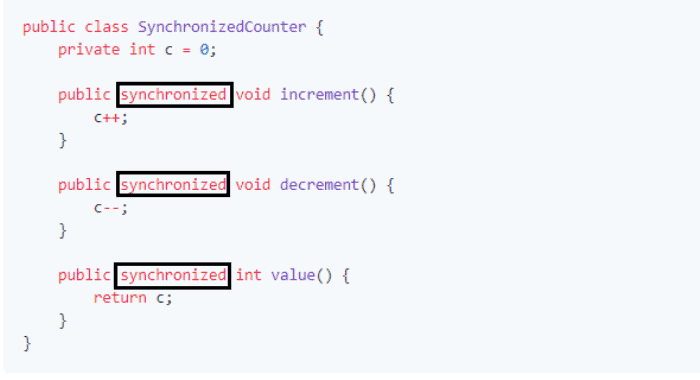
This article will provide an in-depth overview of Synchronization in Java, including using the synchronized keyword, the concept of monitors, and the difference between intrinsic and extrinsic locks. The article will also cover more advanced topics such as reentrant locks, condition objects, and the use of atomic variables.
Whether you’re an experienced Java developer or just starting, this article will provide a comprehensive understanding of Synchronization in Java and help you write robust, efficient, and thread-safe code.
See Also: 10 Best Python Books For Intermediate Programming
Table of Contents
Synchronized Keyword In Java: Importance
Synchronization is essential in multi-threaded environments to ensure the correct execution of a program. Without Synchronization, multiple threads might access the same shared resources simultaneously, leading to data inconsistencies and race conditions. This can result in unexpected behavior and incorrect results. For example, consider a scenario where multiple threads update a bank account’s balance
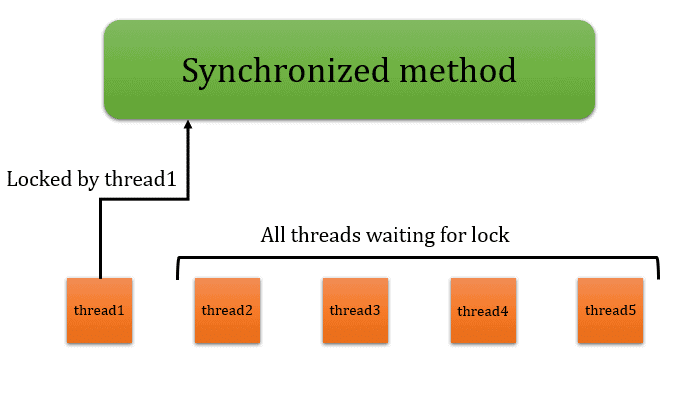 . If the lines are not synchronized, they might access the account balance simultaneously and edit it, leading to incorrect balances and transactions. When multiple threads access shared data, one line might modify it while another uses it. Synchronization ensures that the data is updated consistently and controlled, avoiding data corruption and ensuring that the data is always in a valid state.
. If the lines are not synchronized, they might access the account balance simultaneously and edit it, leading to incorrect balances and transactions. When multiple threads access shared data, one line might modify it while another uses it. Synchronization ensures that the data is updated consistently and controlled, avoiding data corruption and ensuring that the data is always in a valid state.
See Also: SPSS Vs. SAS | Complete Comparison
Types of Synchronization
There are two types of Synchronization:
- Process Synchronization
- Thread Synchronization
Process Synchronization
In Java, process synchronization is achieved using inter-process communication (IPC) mechanisms, such as pipes, sockets, and remote method invocation (RMI).
These mechanisms allow multiple processes to communicate and coordinate their actions, ensuring that they access shared resources in a controlled manner. Java also provides synchronization mechanisms, such as the synchronized keyword and Java.
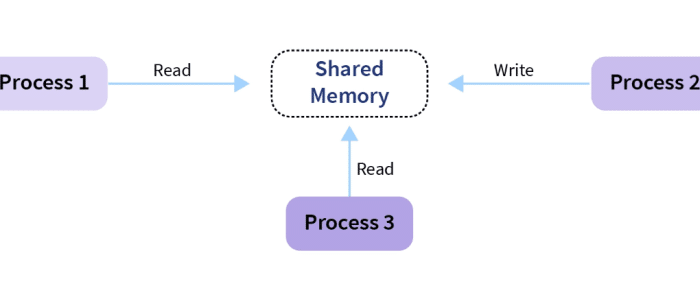 Util. Concurrent—locks package for synchronizing threads within a single process. When using IPC in Java, it’s essential to be mindful of the communication overhead and design the system to keep it to a minimum.
Util. Concurrent—locks package for synchronizing threads within a single process. When using IPC in Java, it’s essential to be mindful of the communication overhead and design the system to keep it to a minimum.
Thread Synchronization
Thread synchronization is a technique used in computer programming to ensure that multiple threads access shared resources in a controlled manner. This is necessary because, without Synchronization, multiple lines might access the same resources simultaneously, leading to data inconsistencies and race conditions.
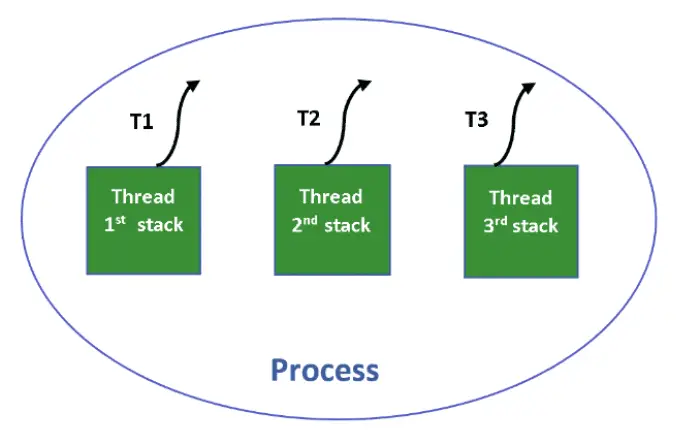
To ensure that numerous threads execute critical sections of code (that access shared resources) serially, thread synchronization is used in Java. Multiple lines might access the same resources without synchronization, leading to data inconsistencies and race conditions. Therefore, it is essential to implement synchronization mechanisms to ensure the correctness and consistency of shared resources.
Java provides multiple ways to synchronize threads. Some of the most common methods are:
Synchronized Method
A synchronized method can control access to an object’s shared resources. Adding the “synchronized” keyword before a method’s declaration ensures that only one thread can execute the technique simultaneously. For example:
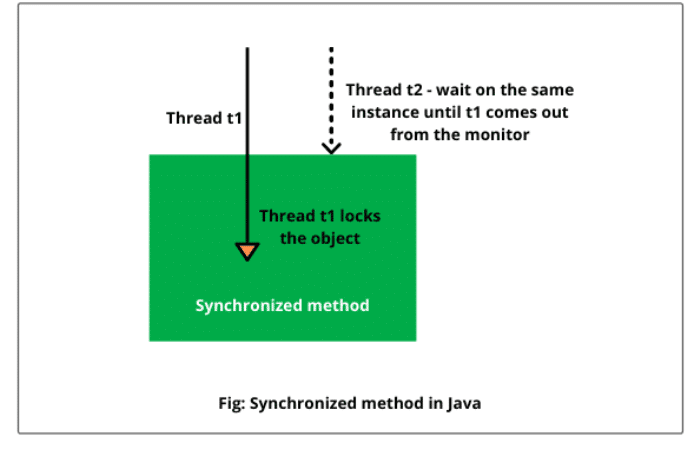
class Counter {
private int count = 0;
public synchronized void increment() {
count++;
}
}
Synchronized Block
A synchronized block can synchronize a portion of code that accesses a shared resource. It’s similar to a synchronized method but allows for more fine-grained control over what part of a method should be synchronized. For example:

java
class Counter {
private int count = 0;
public void increment() {
synchronized (this) {
count++;
}
}
}
Reentrant Lock: Java 5 introduced the Java.util.concurrent.locks.ReentrantLock class, which provides more advanced locking capabilities than the synchronized keyword. For example:
Import java.util.concurrent.locks.ReentrantLock;
class Counter {
private int count = 0;
private ReentrantLock lock = new ReentrantLock();
public void increment() {
lock.lock();
try {
count++;
} finally {
lock.unlock();
}
}
}
Atomic Variables
Java 5 also introduced the Java.util.concurrent.atomic package, which contains classes for performing nuclear operations on variables. These classes provide a convenient way to perform functions on variables that would otherwise require Synchronization. For example:

Import java.util.concurrent.atomic.AtomicInteger;
class Counter {
private AtomicInteger count = new AtomicInteger(0);
public void increment() {
count.incrementAndGet();
}
}
In summary, thread synchronization in Java is a crucial aspect of concurrent programming. It ensures that multiple threads access shared resources in a controlled manner, preventing data inconsistencies and race conditions.
FAQS
How does the synchronized keyword work in Java?
When a thread attempts to enter a synchronized block or method, it must first acquire the lock associated with that block or method. Once the thread has acquired the lock, it can execute the block or method. When the thread exits the block or method, it releases the lock.
What is a race condition in Java?
A race condition in Java occurs when multiple threads access a shared resource simultaneously, resulting in unpredictable behavior and potentially incorrect results.
How can the synchronized keyword prevent race conditions in Java?
By allowing only one thread to access a shared resource at a time, the synchronized keyword can prevent race conditions and ensure that the shared resource is accessed consistently and predictably.
Can the synchronized keyword be used with static methods in Java?
Yes, the synchronized keyword can be used with static methods in Java to synchronize access to static variables and methods.
What happens if a thread tries to enter a synchronized block or method already locked by another thread in Java?
If a thread tries to enter a synchronized block or method already locked by another thread, it will block until the other thread releases the lock.
Conclusion
In conclusion, the synchronized keyword in Java is a powerful tool that controls access to shared resources in multi-threaded environments. By marking a method or a block of code as synchronized, we can ensure that only one thread can execute the critical code section at a time, avoiding race conditions and ensuring data consistency. Understanding and using Synchronization is crucial for writing correct and efficient concurrent programs in Java.
See also: How To Convert Celsius To Fahrenheit In Java?
Enjoys programming, web development experience, experience in web technologies such as HTML, CSS, CSS Bootstrap, PHP, Javascript, MySQL, excellent IT skills.